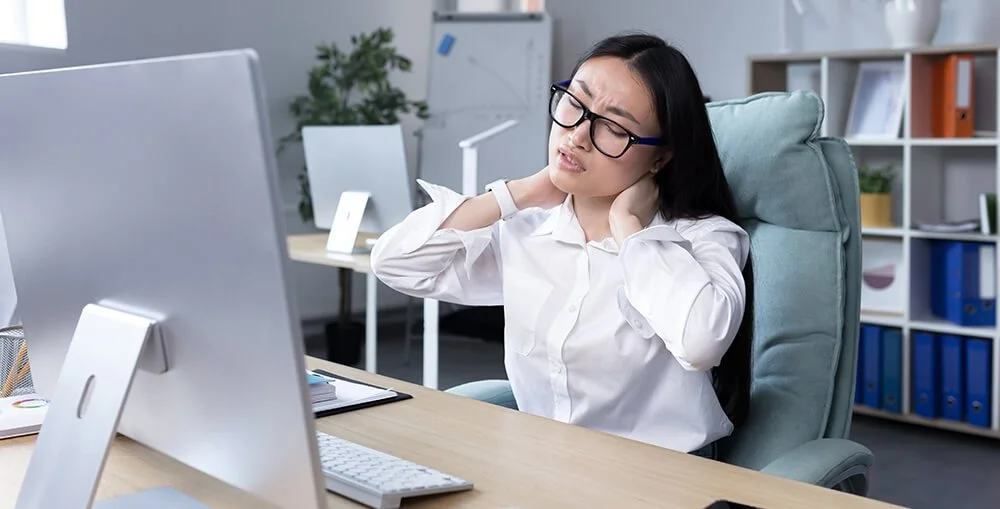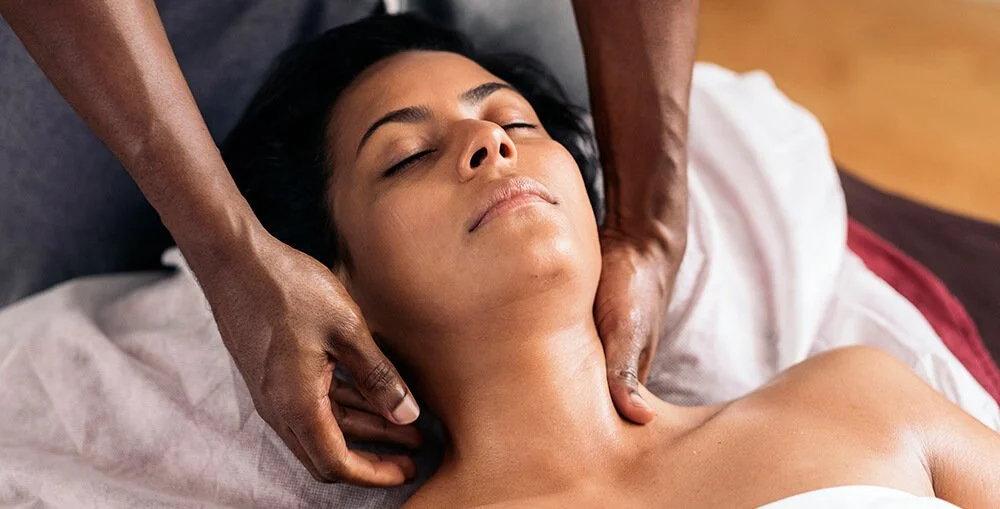RMT Posture Correction: Stand Tall for Better Health
Table of Contents Show
Quick Summary
Discover the causes and effects of bad posture and learn how massage therapy can help correct it. This article explores techniques like sports massage, deep tissue massage, Swedish massage, and myofascial release therapy.
Understand why good posture is crucial for your health and find practical solutions to achieve a healthier, more balanced lifestyle.
Living and working in the bustling city of Vancouver often means long hours at a desk, frequent commutes, and spending substantial time on electronic devices.
These habits can easily lead to poor posture, causing discomfort and long-term health issues without our awareness.
Maybe you have noticed yourself with slouching shoulders, a stiff neck, or persistent back pain. Which if you have then first, you're not alone.
Bad posture can affect people of all ages and backgrounds. But here at the clinic, we can somewhat box them into certain groups that are more susceptible:
Office Workers: Long hours sitting at a desk can lead to slouching and poor ergonomic practices.
Students: Extended periods of sitting and carrying heavy backpacks can strain posture.
Elderly: Age-related muscle weakness and joint issues can contribute to poor posture.
People with Sedentary Lifestyles: Lack of physical activity can weaken core muscles, leading to slouching.
Individuals Under Stress: Stress can cause muscle tension, leading to a hunched or rigid posture.
Athletes: Imbalances from repetitive sports activities can affect posture.
This is why we want to explore what constitutes bad posture, its causes, and its effects on health because here at West End Wellness, we understand the challenges of maintaining good posture and its impact on overall well-being.
We will delve into how massage therapy can help correct posture through various techniques such as sports massage, deep tissue massage, and Swedish massage.
Learning with us and understanding the importance of correct posture is crucial for preventing chronic pain and improving your quality of life.
By addressing these issues, you'll be better equipped to maintain a healthy, balanced body.
Discover how massage therapy can alleviate stress, reduce muscle tension, and improve posture for those long hours at the desk.
What Is Bad Posture?
Bad posture refers to the incorrect alignment of the body while standing, sitting, or lying down.
It often results in an uneven distribution of weight, which can lead to strain on muscles and ligaments. If you’ve ever felt neck or back pain after tasks like cleaning the house or spending long hours at a desk, you’ve likely experienced bad posture.
Bad posture medically occurs when the spinal cord stays bent for extended periods, increasing pressure on joints and ligaments. This pressure can lead to discomfort and long-term issues.
The most common cause of bad posture is prolonged sitting, which is a very relatable cause for most but is easily forgotten about due to focusing on the tasks at hand.
But there is also others who are susceptible to the negative effects of poor posture:
Children and teenagers are at risk as they spend more time hunched over digital devices, carrying heavy backpacks, and sitting for long periods at school
Elderly individuals can develop poor posture as they lose muscle strength and bone density with age, leading to conditions like kyphosis (excessive outward curvature of the spine).
Overweight or obese may struggle with maintaining proper posture due to increased strain on the spine and musculature.
Pregnant women commonly experience posture issues from the added weight and shift in their center of gravity.
Manual labourers performing repetitive motions or heavy lifting are susceptible to muscle imbalances contributing to bad posture.
But one that almost anyone will be able to relate to is anyone who spends excessive time looking down at phones, tablets, or other digital devices can develop a "text neck" or forward head posture. I think we are all guilty of doing this one!
So far, you can start to recognize that whether eating, driving, working, or studying, we often sit incorrectly for extended periods. This can reshape muscles, causing imbalances that maintain poor posture.
For example, sitting hunched over for long periods can cause muscles to adapt to this incorrect alignment, perpetuating the issue.
To combat bad posture, it's essential to be mindful of your body's alignment and to make adjustments as needed.
Regular movement, ergonomic furniture, and posture-correcting exercises can help maintain a healthy posture and prevent related discomfort.
Bad posture can lead to chronic pain and discomfort.
What Causes Bad Posture?
In our fast-paced lifestyle, bad posture can creep in unnoticed, impacting our daily lives. While we have learned about what bad posture is and who is susceptible to the negative effects, we do want to highlight two common causes that can play a pivotal role in creating bad posture:
Weak Muscles: Insufficient muscle strength can fail to support the spine properly, leading to poor alignment and posture issues.
Injuries: Past injuries can cause compensatory postures, leading to chronic misalignment and discomfort.
Poor Biomechanics: Incorrect movement patterns strain muscles and joints, contributing to poor posture over time.
Repetitive Motions: Repeating the same motion frequently can cause muscle imbalances and postural problems.
Genetic Conditions: Some people are predisposed to posture issues due to inherited traits or conditions.
Fatigue: Tired muscles are less capable of maintaining proper posture, leading to slouching or hunching.
Poor Ergonomics: Workstations not set up correctly can force the body into unnatural positions, affecting posture.
Carrying Heavy Bags: Heavy bags, especially on one shoulder, can distort posture and cause muscle imbalances.
Digital Device Use: Looking down at devices for long periods strains the neck and upper back, leading to poor posture.
Carrying Extra Body Weight: Excess weight, particularly around the abdomen, shifts the body's center of gravity, impacting posture.
Having bad posture will lead to negative health effects that can harm other aspects of your physical health. When you are not aligned, your body becomes imbalanced, and this will not only be felt but will also become increasingly difficult for your joints, which can lead to various issues such as:
Muscle weakness and atrophy
Decreased flexibility
Increased pressure on the spine, leaving it more vulnerable to injury and degeneration
Chronic neck, back and shoulder pain
Back, hip, knee and foot injuries
Stiffness
Fatigue
Headaches
Difficulty breathing
Carpal tunnel syndrome
Sciatica
Impingement and nerve compression
RMTs can help you correct posture by relieving muscle tension.
How Massage Therapy Can Fix Posture
Massage therapy is a vital component of overall health and wellness. It offers relief from various issues, including chronic pain, stress, and muscle tension.
One significant benefit of massage therapy is its ability to correct poor posture. Massage helps realign the body and improve posture by addressing muscle imbalances and promoting relaxation.
While there are many options regarding massage techniques, your registered massage therapist will probably advise you on the right massage to treat your health condition. However, this article will explain four types of massage you may experience.
Sports Massage
Do not be fooled by the name, sports massage isn't just for athletes. This massage focuses on targeting soft tissues with pressure tailored to your preference.
The immediate benefit is improved blood circulation, which increases muscle temperature and flexibility. As muscles and joints relax and become more elastic, posture naturally improves, reducing pain and tension.
Deep Tissue Massage
Deep tissue massage focuses on the deeper layers of muscle and connective tissue. This helps increase mobility as muscles relax and adjust to their natural positions. The deep pressure also alleviates pain, supporting better posture and overall muscle health.
It is also particularly effective in releasing chronic muscle tension and knots, which can help realign the body and improve posture.
Swedish Massage
Swedish massage is ideal for both physical relief and mental relaxation. A massage therapist uses firm or gentle pressure to target areas with the most tension, such as the lower back or shoulders.
This holistic approach reduces physical pain and stiffness and enhances mental relaxation and mood, promoting a more balanced and aligned posture.
Myofascial Release Therapy
Myofascial release therapy relieves tension in the fascia, the connective tissue surrounding muscles. Applying gentle, sustained pressure helps to release tightness and improve flexibility.
This release of tension can correct muscle imbalances, enhance mobility, and support proper posture alignment. It is particularly effective for chronic pain and areas with persistent tightness.
FAQ
Can an RMT help with posture?
Yes, a Registered Massage Therapist (RMT) can assess your posture and provide treatments to address muscle imbalances and tension, helping to improve your alignment.
Is RMT hard on your body?
While RMT treatments can involve deep pressure, they are tailored to your comfort level and specific needs. The goal is to relieve tension and improve function, not to cause pain.
Can a massage therapist align your spine?
Massage therapists do not directly align the spine like chiropractors, but they can work on the muscles and tissues surrounding the spine to improve overall alignment and posture.
Conclusion
Maintaining good posture is essential for overall health and well-being, especially for those working hard in a busy city like Vancouver.
Regular massage therapy can be crucial in correcting posture, relieving pain, and enhancing quality of life. This is especially true for those with rounded shoulders, as a 2017 study showed that massage therapy can significantly improve shoulder range of motion.
Remember that our bodies adapt to the postures we adopt, and as we age, it can become more difficult to break these bad habits.
But with a few changes to your daily habits and remembering key points in this article, you should be on your way to improving your posture and overall health.
If you have any further doubts or questions regarding this subject or another treatment, contact one of our experienced Acupuncturists or Registered Massage Therapists here at West End Wellness Clinic. You can either give us a call or make an appointment.
Disclaimer: Please remember this article is for informational purposes only and should not replace professional medical advice. Please consult a healthcare provider or someone with the correct qualifications before starting any new exercise or treatment program.




